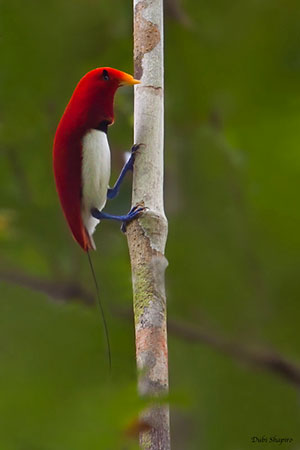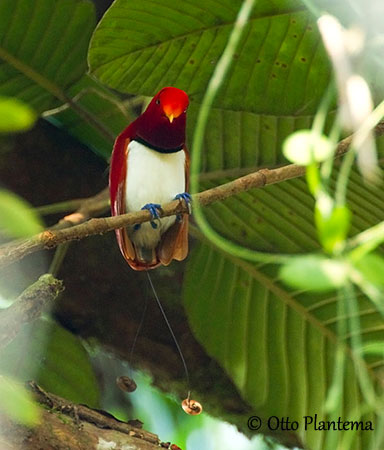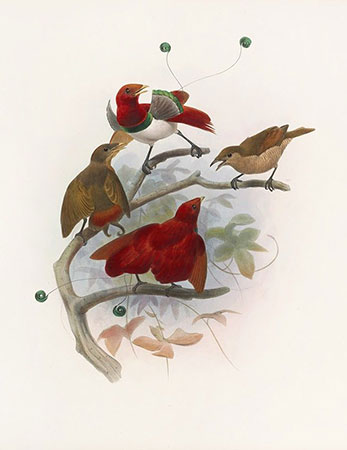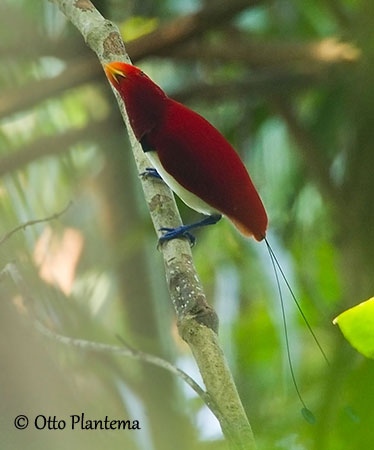
PROTECTION / THREATS / STATUS:
The King Bird-of-paradise is described as locally fairly common and widespread, but it is patchily distributed.
The species is affected by habitat loss and heavy hunting pressure.
The size of the population is unknown, but it is not globally threatened.
The King Bird-of-paradise is currently evaluated as Least Concern.
Fr: Paradisier royal
Ang: King Bird-of-paradise
All: Königsparadiesvogel
Esp: Ave del paraíso real
Ita: Uccello del paradiso reale
Nd: Koningsparadijsvogel
Sd: kungsparadisfågel
Photographers:
Otto Plantema
Trips around the world
Dubi Shapiro
Dubi Shapiro Photo Galleries
Illustration:
Daniel Giraud Elliot (1835 – 1915)
Text by Nicole Bouglouan
Sources:
HANDBOOK OF THE BIRDS OF THE WORLD Vol 14 by Josep del Hoyo-Andrew Elliot-David Christie - Lynx Edicions – ISBN: 9788496553507
Les Oiseaux de paradis – Histoire Naturelle et photographies - par Michel Ottaviani - Editions Prin, France – ISBN : 2-909136-40-X
Birds of Paradise and Bowerbirds De Phil Gregory – Editeur: Bloomsbury Publishing, 2020 – ISBN: 1472975847, 9781472975843 – 416 pages
Birds of New Guinea: Second Edition De Thane K. Pratt, Bruce M. Beehler – Editeur: Princeton University Press, 2014 – ISBN: 0691095639, 9780691095639 – 528 pages
Birds of New Guinea: Distribution, Taxonomy, and Systematics De Bruce M. Beehler, Thane K. Pratt – Editeur: Princeton University Press, 2016 – ISBN: 069116424X, 9780691164243 – 672 pages
Book of Curious Birds De Jennifer Cossins – Editeur: Hachette UK, 2021 – ISBN: 073442048X, 9780734420480 – 64 pages
Astonishing Animals: Extraordinary Creatures and the Fantastic Worlds They ... De Tim Flannery – Editeur: Open Road + Grove/Atlantic, 2012 – ISBN: 0802194176, 9780802194176 – 192 pages
Bird: The Definitive Visual Guide De DK – Editeur: Dorling Kindersley Ltd, 2022 – ISBN: 0241596319, 9780241596319 – 512 pages
Booth Bird of the Month: December – Cicinnurus regius, King bird-of-paradise
Pupperish -With Its Vivid Colors, King Bird-Of-Paradise Is A Living Gem
King Bird Of Paradise (cicinnurus Regius): Species Accounts
CREAGUS@Monterey Bay (Don Roberson)
Fatbirder - The World’s Richest Information Resource about Birds for Birders
Wikipedia, the free encyclopaedia
King Bird-of-paradise
Cicinnurus regius
Passeriformes Order – Paradisaeidae Family
INTRODUCTION:
The King Bird-of-paradise is found in mainland New Guinea and on Aru, Salawati, Misool and Yapen Islands, where it frequents humid forest habitats. The diet includes fruits and arthropods found while foraging at various forest levels.
The male is polygynous and performs spectacular displays in arboreal court created in thick subcanopy vines within the forest. The male may display alone or in an exploded lek including 2-4 males. The complex display involves several phases during which the bright-coloured plumage is conspicuously used to attract the females.
Like in most bird-of-paradise species, the female alone performs the nesting duties.
The King Bird-of-paradise is fairly widespread but patchily distributed. The usual threats are habitat loss and hunting pressure, but currently, the species is not considered globally threatened.
DESCRIPTION OF THE BIRD:
Biometrics:
Length: M: 16 cm (31 cm with central rectrices) – F: 19 cm
Weight: M: 43-65 g – F: 38-58 g
The King Bird-of-paradise adult male has bright red upperparts, chin and breast. On the upperparts, the elongated feathers of the mantle (especially of the cape), back, rump, tertials and some upperwing-coverts are crimson to carmine with white iridescence. The upperwing is mainly glossy crimson, whereas the flight-feathers and some coverts are variably brown. The uppertail-coverts are duller and more orange.
The tail is dark brownish-olive, with brown-orange outer feather edges. The elongate central pair of rectrices is conspicuous. They are wire-like ornamental tail-feather shafts, tipped with a circular swirl of bright green feathers. The bare central shafts are red-brown.
On the underparts, the crimson feathers of the lower throat are finely tipped pale buff where they meet the narrow breast shield of iridescent dark green feathers (it may appear jet black to green-yellow depending on the light).
Several elongate erectile, fan-shaped olive-brown feathers can be seen on each side of the shield during the displays. They show a broad iridescent tip of metallic bright green and are called “pectoral fans”. The remaining underparts are white.
On the crimson head, forecrown and tuft of elongate feathering over culmen base are more orange. There is a black spot over each eye, showing iridescent dark green gloss.
The ivory-yellow bill has the upper ridge of the culmen similar to knife edge. The mouth is pale aqua-green. The eyes are pale to dark brown or greyish-brown. Legs and feet are cobalt-blue to blue-grey.

The adult female is much duller than male. The upperparts are olive-brown with rusty edges to greater coverts, flight-feathers and rectrices. The tail is longer but the wire-like central rectrices are absent.
On the underparts, breast, flanks and lower belly are buff. Rest of underparts is whitish and finely barred dark brown.
On the head, we can see a paler area above the eye. Bill, legs and feet are duller than in adult male.
The juvenile has brown crown washed russet, and pale supercilliary stripe with a dark spot above. The upperparts are grey-brown including the tail. The wing feathers are darker brown whereas greater coverts and outer primaries are red-brown.
On the underparts, the chin is grey with brownish-yellow tinge and fine streaks and spots. Rest of underparts is pale grey with dark barring.
The bill is horn-coloured. The eyes are grey-brown. Legs and feet are paler blue than in female.
The immature male resembles adult but the dark-billed younger individuals have orange-rufous wash on the usually red parts of the plumage.
Both immature and subadult males acquire progressively the bright-red adult plumage, while the central pair of rectrices becomes progressively longer.
SUBSPECIES AND RANGE:
The King Bird-of-paradise has two subspecies.
C.r. regius (described above) is found in West Papuan Islands including Salawati, Misool and Aru Islands, and mainland New Guinea except the northern part.
C.r. coccineifrons is found in N New Guinea, from E coast of Geelvink Bay E to E Ramu R and also on Yapen Island.
This race is very similar to nominate, but both bill and central pair of rectrices are slightly longer. The dark mark above the eye is a narrow slash rather than a spot.
HABITAT:
The King Bird-of-paradise frequents lowland rainforest, monsoon and gallery forest and edges, and also disturbed and tall secondary forest. The species is visible from sea-level to 950 metres of elevation, but usually, it occurs mainly between 300 and 400 metres.
CALLS AND SONGS: SOUNDS BY XENO-CANTO
The King Bird-of-paradise has several varied advertising calls and some of the most typical are described as a descending “wher-wher-wha”, a deep “kraaa-kraaa-kraaa”, and also a rising series of loud, throaty “cho-chow-chaw-chaw-chaw-chaw chai”. We can also hear a lower-pitched, slowly delivered “krahn krahn krahn krahn” and a high insistent “ki kyer kyer kyer kyer kyer kyer kyer kyer kyer” rapidly delivered and falling in speed and pitch towards the end.
It also produces a plaintive “weeo-weeo” while foraging.
During the courtship displays, several sounds given by the adult male are described as subdued chittering of rhythmic twittering, churring, buzzing and grating notes continuously uttered.

BEHAVIOUR IN THE WILD:
The King Bird-of-paradise feeds on small fruits and arthropods. The fruits are swallowed whole or consumed piece by piece, depending on their size. The diet varies according to the local food resources.
The species forages at various levels of the forest, from the understorey to the lower canopy, and it may sometimes come lower to near the ground level.
Insects are caught by gleaning from foliage, branches and other vegetation.
It also may join mixed-species foraging flocks, especially the female-plumaged birds.
The King Bird-of-paradise performs elaborate courtship displays in an arboreal court placed in the thick subcanopy vines, usually in shade within the forest. There are hanging vines and the bird is known to defoliate its favourite perches.
The system of the King Bird-of-paradise is intermediate between a non-territorial one and an exploded lek. The courting males can be solitary individuals placed 150-530 metres or more apart, to several males clustered together.
The male starts to display in the early morning and continues to late afternoon. However, it is less active during the hot sunny days whereas a cloud cover seems to be optimal for displaying.
The displays of the King Bird-of-paradise are complex and include two display types. The first display enhances both pectoral fans and tail wires, while the second one exposes the open, vibrating wings. The male moves up the vines or branches of the display tree by performing zigzagging hops and moving the body from side to side.
Several phases are observed. They are named Wing-cupping Phase, Dancing Display, Tail-swinging Phase, Horizontal Open Wings Display, Inverted Phase of the previous one, Silent Pendulum Display and the last Pendulum Display ending the seven phases.
During the first three displays, the wings are spread and vibrating, then the plumage is fluffed out and the body is vibrating while the bird shakes the tail wires. In the following phase, the tail is switched from side to side and the surrounding vines do the same in wide arcs.

Daniel Giraud Elliot
(1835 – 1915)
During the Horizontal Open Wings Display, both wings are spread out and forwards while the body is parallel to the branch. The wings vibrate as the body moves from side to side. This display is silent.
The Inverted Phase follows. The bird briefly rocks from side to side and the wings are vibrating. Suddenly, the male drops to cling below the perch and repeats the display. It turns the head from side to side with the bill open to expose the aqua-green mouth before closing the wings, and tightly sleeks its plumage while remaining suspended. It swings several times from side to side at an increasing tempo during the brief and Silent Pendulum Display.
And finally, the displays end when the bird rights itself atop the perch, but it also may simply drop down and away from the perch.
During these displays, the King Bird-of-paradise uses its wings conspicuously while moving the pectoral fans and the tail wires.
As usual, the female leaves after mating and performs alone all the nesting duties.
The King Bird-of-paradise is presumably resident.
As in most Paradisaeidae species, the flight is undulating with flap-and-glide action interspersed with the wings held closed against the body.
REPRODUCTION OF THIS SPECIES:
The King Bird-of-paradise probably breeds all year round over the range, and at least from March to October.
The nest is built by the female.
From an observation in Western province of Papua New Guinea, a nest was described as a cup-shaped structure made of twigs and small dry leaves. It was placed high on a fern clump that was growing on a vine.
Another nest found in Aru Islands was placed in tree hole, two metres above the ground. It was filled with palm fibres.
The female lays 1-2 creamy-pink eggs with dark brown markings. The incubation by the female alone lasts 17 days (in captivity). The chicks are mainly fed with arthropods. The nestlings are naked at hatching, with dark red skin and yellow gape.
